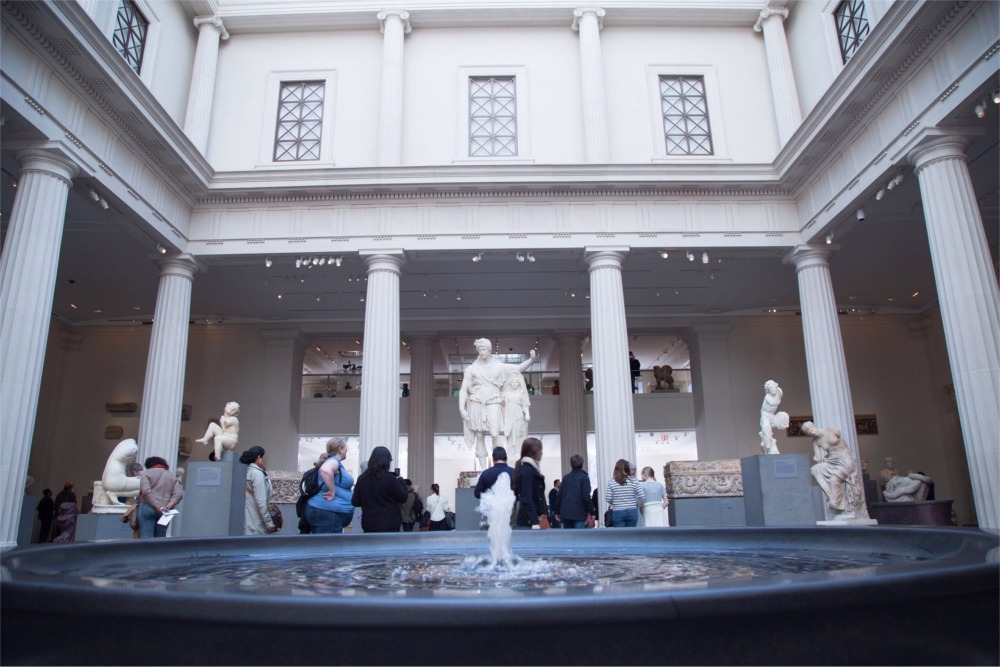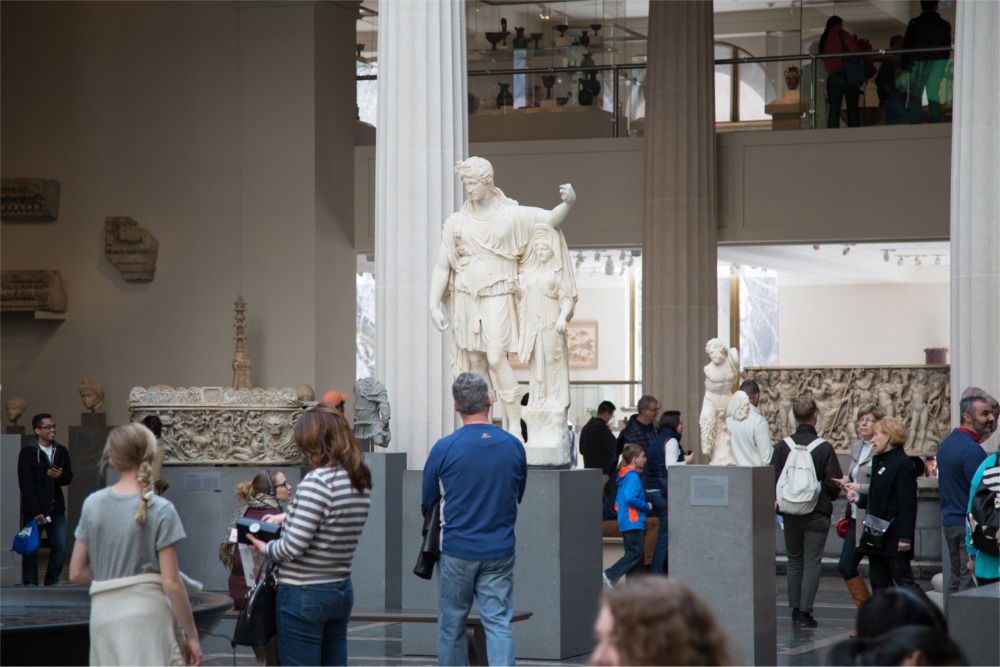Statue of Dionysos
Home > New York State Photographs > Metropolitan Museum of Art > Statue of Dionysos


These photographs show a Statue of Dionysos leaning on a female figure (Hope Dionysos circa 27 B.C.–A.D. 68) housed in the Greek and Roman galleries at the Metropolitan Museum of Art in New York City.
Dionysus
Dionysus is the god of the grape harvest, winemaking, orchards and fruit, vegetation, fertility, insanity, ritual madness, religious ecstasy, festivity, and theatre in ancient Greek religion and myth. He is also known as Bacchus by the Greeks. This name was later adopted by the Romans; the frenzy that he induces is bakkheia. As Eleutherios ("the liberator"), his wine, music, and ecstatic dance free his followers from self-conscious fear and care, and subvert the oppressive restraints of the powerful. His thyrsus, a fennel-stem sceptre, sometimes wound with ivy and dripping with honey, is both a beneficent wand and a weapon used to destroy those who oppose his cult and the freedoms he represents. Those who partake of his mysteries are believed to become possessed and empowered by the god himself.
His origins are uncertain, and his cults took many forms; some are described by ancient sources as Thracian, others as Greek. In Orphic religion, he was variously a son of Zeus and Persephone; a chthonic or underworld aspect of Zeus; or the twice-born son of Zeus and the mortal Semele. The Eleusinian Mysteries identify him with Iacchus, the son or husband of Demeter. Most accounts say he was born in Thrace, traveled abroad, and arrived in Greece as a foreigner. His attribute of "foreignness" as an arriving outsider-god may be inherent and essential to his cults, as he is a god of epiphany, sometimes called "the god that comes".
Wine was a religious focus in the cult of Dionysus and was his earthly incarnation. Wine could ease suffering, bring joy, and inspire divine madness. Festivals of Dionysus included the performance of sacred dramas enacting his myths, the initial driving force behind the development of theatre in Western culture. The cult of Dionysus is also a "cult of the souls"; his maenads feed the dead through blood offerings, and he acts as a divine communicant between the living and the dead. He is sometimes categorised as a dying-and-rising god.
Romans identified Bacchus with their own Liber Pater, the "Free Father" of the Liberalia festival, patron of viniculture, wine, and male fertility, and guardian of the traditions, rituals, and freedoms attached to coming of age and citizenship, but the Roman state treated independent, popular festivals of Bacchus (Bacchanalia) as subversive, partly because their free mixing of classes and genders transgressed traditional social and moral constraints. Celebration of the Bacchanalia was made a capital offence, except in the toned-down forms and greatly diminished congregations approved and supervised by the State. Festivals of Bacchus were merged with those of Liber and Dionysus.
The Metropolitan Museum of Art of New York
The Metropolitan Museum of Art in New York City, colloquially "the Met", is the largest art museum in the Americas. Its permanent collection contains over two million works, divided among 17 curatorial departments. The main building at 1000 Fifth Avenue, along the Museum Mile on the eastern edge of Central Park on Manhattan's Upper East Side, is by area one of the world's largest art museums. A much smaller second location, The Cloisters at Fort Tryon Park in Upper Manhattan, contains an extensive collection of art, architecture, and artifacts from medieval Europe.
The Metropolitan Museum of Art was founded in 1870 with its mission to bring art and art education to the American people. The museum's permanent collection consists of works of art from classical antiquity and ancient Egypt, paintings, and sculptures from nearly all the European masters, and an extensive collection of American and modern art. The Met maintains extensive holdings of African, Asian, Oceanian, Byzantine, and Islamic art. The museum is home to encyclopedic collections of musical instruments, costumes, and accessories, as well as antique weapons and armor from around the world. Several notable interiors, ranging from 1st-century Rome through modern American design, are installed in its galleries.
The Fifth Avenue building opened on March 30, 1880. In 2021, despite the COVID-19 pandemic in New York City, the museum attracted 1,958,000 visitors, ranking fourth on the list of most-visited art museums in the world.
From Wikipedia, the free encyclopedia.


